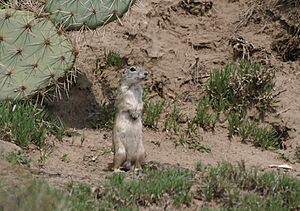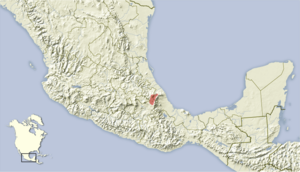Perote ground squirrel facts for kids
Quick facts for kids Perote ground squirrel |
|
|---|---|
 |
|
| Conservation status | |
| Scientific classification | |
| Genus: |
Xerospermophilus
|
| Species: |
perotensis
|
| Synonyms | |
|
Spermophilus perotensis Merriam, 1893 |
|
The Perote ground squirrel (Xerospermophilus perotensis) is a type of rodent that belongs to the Sciuridae family, which includes squirrels. This special squirrel lives only in Mexico, meaning it is endemic there. Sadly, it is currently at risk of disappearing forever.
Perote ground squirrels often share their living areas with other squirrels, like rock squirrels (Otospermophilus variegatus) and sometimes even the Mexican ground squirrel (Ictidomys mexicanus). However, Perote ground squirrels prefer slightly different spots within these shared habitats.
Contents
About the Perote Ground Squirrel
Perote ground squirrels look a bit like spotted ground squirrels (X. spilosoma pallescens) found in northern Mexico. But Perote ground squirrels are bigger. They also have shorter tails and yellow fur on their backs. Their skulls are narrow, with a large area for their brain, and they have strong, thick teeth.
These squirrels have two main parts to their year. From March to November, they are very active. Then, from December to February, they go into hibernation to sleep through the colder months. Sometimes, these active and hibernation periods can overlap a little in March and November.
Scientists first described X. perotensis as its own species in 1893. Today, many researchers are studying it closely. Some think it might actually be a subspecies of X. spilosoma. Either way, it's clear that the Perote ground squirrel is a unique animal. It has developed on its own in a specific area because of past climate changes.
Family Tree and Relatives
The closest relative of the Perote ground squirrel is thought to be the spotted ground squirrel (X. spilosoma). These two types of squirrels separated from each other a long time ago. This happened between 1.2 and 3.3 million years ago. It was due to big climate changes during a period called the Pleistocene Ice Age.
Home Sweet Home: Habitat and Range
The Perote ground squirrel lives in an area called the Oriental Basin in Mexico. This basin covers about 5,250 square kilometers between the states of Puebla and Veracruz. High mountains surround this basin. These mountains likely formed from volcanoes. This also explains why there are dry and semi-dry areas within the basin.
The semi-dry land in Perote is the wettest part of the area. It gets about 370 millimeters of rain on average between June and September. The average temperature is around 11.9 degrees Celsius. It can get as warm as 14.7 degrees Celsius and as cool as 8.8 degrees Celsius.
Perote ground squirrels only live in certain places. These include alkaline grasslands, dry scrublands, and rocky, hilly areas. This is where they dig their burrows. However, their suitable habitat is shrinking. This is due to farming, too much overgrazing by livestock, and cities growing. Now, they only live in about 16 small areas. These areas are often narrow strips, only 20 to 50 meters wide. They are also separated by an average distance of about 15.8 kilometers.
This species is in danger because its habitat is being broken up. Also, forests are being cut down for timber extraction and to make room for farms. The squirrel used to live across about 5,250 square kilometers. Now, it only lives in about 2,457 square kilometers. The Oriental Basin is almost completely surrounded by mountains. These mountains stop the squirrels from moving to new habitats. The basin itself has lava flows, isolated mountains, and volcanoes. This means there are only small, specific spots where the squirrels can live.
What Do Perote Ground Squirrels Eat?
The Perote ground squirrel is a "generalist" when it comes to food. This means it eats many different things. They are often found in farmlands and open areas with short plants. When scientists try to catch them for studies, they often use oats as bait in their traps.
Life Cycle and Reproduction
Perote ground squirrels live in family groups. Each family usually stays within its own burrow system. Sometimes, male squirrels will leave their burrow to find females in other areas. This can cause fights between adult males and younger males. These fights often make the younger males move away.
Adult males become active in March, even before the younger squirrels and females. Mating happens between April and May. Female squirrels that are pregnant or nursing their babies are most common from June to August. On average, a female squirrel has about six embryos. About four of these usually grow into live young squirrels.
Because their habitat is being destroyed and broken up, there are fewer chances for squirrels to breed with different families. This can lead to inbreeding, where squirrels mate with close relatives. However, studies have shown that inbreeding has not had a big effect on their genes so far.
Protecting Their Genes
The Perote ground squirrel's home is becoming more and more broken up. This has caused a big drop in their genetic diversity. Genetic diversity means how much variety there is in the genes of a population. Scientists have compared the mitochondrial DNA of current squirrels with old museum specimens. They found a decrease in different types of genes, called haplotypes, and overall genetic variety.
Squirrels are usually expected to have a lot of genetic variety. This is because they have many babies and new generations quickly. But the Perote ground squirrel is different. Scientists are worried that this loss of genetic diversity could lead to their extinction. Experts suggest taking action to help increase their genetic diversity. One idea is to move some squirrels between the 16 different small groups. This would help them breed with new partners.
What Threats Do They Face?
Animals can react to environmental change in three main ways. They can move to a new place that suits them. They can change over time (evolve) or get used to new conditions. Or, they can disappear from an area.
The Perote ground squirrel has very specific needs for its environment. This means there isn't really another place for them to move to. Some studies show that because the Perote ground squirrel is a seasonal animal, it is more affected by climate change. This increases its risk of extinction. Seasonal animals are more vulnerable because they have to do all their yearly activities in a shorter time. They don't move to new places. Instead, they have to adjust their activities, like hibernation, to the current climate.
The squirrel also has natural enemies. These include the long-tailed weasel (Mustela frenata) and even domestic dogs. These predators can also affect the squirrel's population numbers.
The Future of the Perote Ground Squirrel
Small mammals that live on the ground are very important. They are sometimes called "ecosystem engineers." This is because they help the soil by adding organic material. They also help water soak into the ground and change the soil's structure. This helps different plants grow and keeps underground water sources healthy. Their burrows also provide homes for many other animals, both large and small.
Ground squirrels are also an important food source for many predators. Some predators rely heavily on them, especially when they are raising their young. If the Perote ground squirrel were to disappear, it would cause a big change in the ecosystem.
There is still much we don't know about the Perote ground squirrel. Even though it is an endangered species, we need to learn more. Future studies might help us find ways to protect this important animal in the Oriental Basin of Mexico. Sadly, many experts fear the squirrel will become extinct without help from humans.



